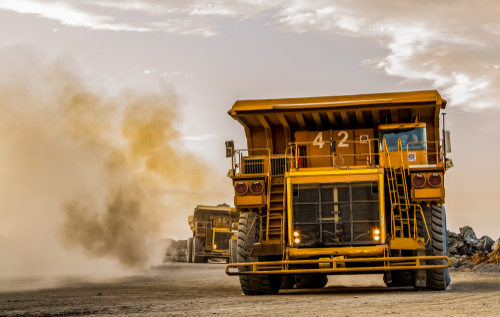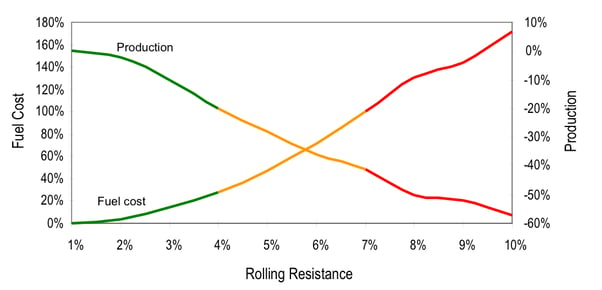
Cutting emissions by reducing rolling resistance
One of the most cost-effective and efficient ways that mines can achieve a reduction in fuel usage is to invest in improving the surface quality of roads across a haul network.
This is because the amount of diesel consumed by haul trucks is dramatically increased when road networks have poor rolling resistance due to rough, uneven and loose surfaces. It is widely accepted in the mining industry that there is a strong correlation between rolling resistance and fuel consumption as illustrated in the chart below.

As leaders in the field of haul road management, Dust-A-Side Australia wanted to prove that by reducing rolling resistance, mines can achieve a reduction in fuel consumption. So we commissioned leading tyre manufacturer Michelin to conduct a special study at their cutting-edge mining test centre in Spain.
The study conducted by Michelin assessed the impact of Dust-A-Side ’s haul road management program on the fuel consumption of rigid dump trucks.
Treatment carried out by Dust-A-Side included stabilising and sealing the wearing course layer of the road in order to create a smooth-running surface. A dust control binder was also applied to the road to minimise wheel generated dust as a spray on treatment.
The test conditions were set to a reduced scale automated truck, at constant speed, with a pulling effort simulating a constant slope of 10% and on stabilised operating conditions.
When comparing a stone-covered (untreated) reference road and a section of road which had been treated by Dust-A-Side , a substantial 7.5% reduction in fuel consumption was measured.
Taking into account different trucks and variable speeds and slopes led Michelin to a reasonable conclusion that the overall reduction in hourly fuel consumption was 3%-5% on average on a Dust-A-Side treated haul road.
Let’s take a look at an example scenario using conservative estimates to determine how much carbon dioxide one haul truck can emit over a one year period.
Example: The haul truck consumes approximately 75 litres per hour working 24 hours per day at 85% equipment availability. This amounts to 550,000 litres of diesel per year. We can calculate what this means in terms of carbon dioxide emissions using the table below.
| Fuel Type | Unit of Measurement | Kg carbon dioxide equivalent (CO2e) |
| Coal | 1 kilogram (kg) | 2.88165 |
| Wood | 1 kilogram (kg) | 0.61522 |
| Fuel oil (heavy oil, furnace oil) | 1 litre (l) | 3.17799 |
| LPG/propane/butane | 1 litre (l) | 1.51906 |
| Gasoil/diesel-oil | 1 litre (l) | 2.68779 |
| Burning oil (e.g. kerosene) | 1 litre (l) | 2.53627 |
| Petrol/gasoline | 1 litre (l) |
2.20307 (biofuel blend) 2.30531 (no biofuel) |
| Natural gas | 1 cubic metre (m3) | 2.04652 |
Source for CO2e conversions: https://www.gov.uk/government/collections/government-conversion-factors-for-company-reporting
If one litre of diesel is 2.68 kg of carbon dioxide equivalent (CO2e), then over a one year period, the truck will have produced approximately 1,474,000 kg of CO2e. This can be better expressed as 1,474 metric tonnes of CO2e. For comparison, light vehicles such as cars, 4x4s and SUVs produce up to 3.5 metric tonnes annually.
Many haul trucks will operate more frequently than this and consume more diesel, however this example illustrates a ballpark idea about emission levels. Not only will this cut carbon emissions, but operations will be more profitable in the long-run, with fuel prices at historic highs.
So by taking steps to improve haul road surfaces in order to make them smoother and more stable, better fuel efficiencies can be achieved. Ultimately, this means less GHG emissions being released into the atmosphere.
Additional benefits
Stabilising and sealing the wearing course layer of a haul road offers several significant additional benefits beyond reducing fuel consumption and GHG emissions. Firstly, by creating a superior running surface, it reduces the frequency of grading and resheeting activities, leading to reduced associated maintenance costs.
Furthermore, the use of stabilising and sealing products significantly decreases the need for constant road watering to control dust generated by vehicle traffic. This is especially vital in large open-cut mining operations, where a large water cart fleet is traditionally required to keep roads dust-free. The resulting reduction in water cart usage translates to substantial savings in operating hours and, critically, fuel consumption.
Additionally, the improved road surface preserves the integrity of tires, which are oil-based products, contributing to cost savings that cascade down the supply chain.
In summary, stabilising and sealing the wearing course layer not only enhances rolling resistance but also optimises overall mine operations and maintenance, resulting in a more environmentally sustainable and cost-effective haul road management strategy.
Interested in learning more about how Dust-A-Side Australia can help improve the running surface of your haul roads?
Simply click here to arrange an on-site technical consultation and report.
We’ll provide you with a detailed cost analysis based on the size of your haul road network.
We’ll also provide you with figures showing how soon you’ll break even by engaging our services and how much you will be likely to go on and save on fuel and other operating costs.




